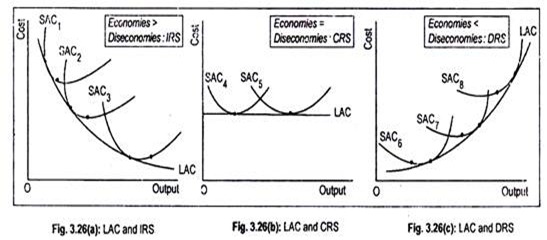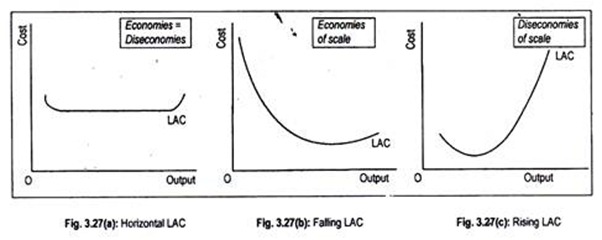The LAC curve is U-shaped because, in the long run, what we find is the operation of the laws of returns to scale.
We also know that the laws of returns to scale have three phases:
Increasing returns to scale (IRS), constant returns to scale (CRS), and diminishing returns to scale (DRS).
In other words, as the scale of operation and the size of the plant become large a firm experiences both internal and external economies of scale.
ADVERTISEMENTS:
Because of the operation of both internal economies (such as, technological economies, managerial economics, risk-bearing economies, etc.,) and external economies (such as economies of specialization, economies of research and development, etc.,) of production, a firm initially experiences IRS which brings down costs of production. That is why the LAC curve initially declines [Fig. 3.26(a)].
However, these economies of large scale production can never be infinite. Sooner or later a time will be reached when both economies and diseconomies of scale will balance each other. Consequently, CRS will set in. In this phase, the LAC curve will become parallel to the horizontal axis indicating constant costs for a certain period of time [Fig. 3.26(b)]. Here the firm also experiences least cost per unit of output.
But once this optimum stage is crossed, both internal and external diseconomies of scale will become operative. As a result, DRS or increasing cost will come into operation. And because of the increasing cost the LAC curve is upward sloping as the scale of operation becomes larger [Fig. 3.26(c)].
Thus, these three phases of the law of returns to scale or the economies and diseconomies of large scale production explain the U-shaped behaviour of the LAC curve.
ADVERTISEMENTS:
It is said that the analysis of long run cost behaviour depends on the principle of returns to scale. However, such assumption may not always hold good. Economists have shown that the LAC curve may show a declining trend over a long range of output in various manufacturing industries.
Again, others have shown that, in general, theoretically the LAC curve need not be U-shaped; in practice, it may never be. It may not be L-shaped [Fig. 3.27] too.
Empirical evidence drawn from the industrial production of the American economy suggests that the curve LAC may take any of the following shapes:
ADVERTISEMENTS:
There may be L-shaped LAC curve—Fig. 3.27(a). Constant costs are the most dominant costs, where economies of scale are obtained for a small number of output, because for a little amount neither economies nor diseconomies of scale are evident.
In Fig. 3.27(b), as economies of scale are prominent, LAC may have a long falling portion and in Fig. 3.27(c), LAC may have a long rising portion. Diseconomies of scale are found to be stronger.

